Where Is an Analogous Color for Blue on the Color Wheel
Almost everyone will immediately recognize a color wheel when they see one. Many often have memories of creating one in school during art class – however few know what it really is. The precise definition of a color wheel is: 'a circle that illustrates the relationships between primary colors, secondary colors, tertiary colors and so on'.
In this article I will teach you the basic concepts of the color wheel and how color works. In addition, I will show you how to apply that knowledge to your painting. Knowing and understanding the underlying concepts behind the color wheel can help you grow your color mixing skills!
Contents of this Article
- Introducing the artist color wheel
- The theory behind the color wheel is important
- Primary color wheel
- Secondary colors in the color wheel
- Complementary colors within the color wheel
- Complementary colors in action
- Mixing complementary colors
- Tertiary Colors in the color wheel
- What are analogous colors?
- Analogous colors definition
- Analogous Colors examples
- Extended analogous colors
- Analogous Colors in Art
- Complementary colors with an analogous palette
- Split complementary colors in the color wheel
- Example of split complementary colors
- Examples of complementary color schemes in art
- Where to find the use of the Color wheel in art
- Orange – blue complementary color scheme
- Yellow – purple complementary scheme
- Red – green complementary scheme
- Practical application of the color wheel
Introducing the artist color wheel

The artist color wheel above shows 12 colors. Starting from the top going clockwise the colors are: red, red-orange, orange, yellow-orange, yellow, yellow-green, green-yellow, green, green-blue, blue, blue-purple, purple, and pink.
The theory behind the color wheel is important
What is behind color wheel theory and understanding what it represents is what is most important. The color wheel itself is not really that important actually!
Rather, once you understand the principles behind what the color wheel represents, it will purely serve as a visual reminder to yourself. You will not need to paint with it in your hand, however it can be helpful to have it hanging on your studio wall as a reference.
If you haven't yet – get my FREE Color Mixing Guide for additional help with color mixing techniques!
Primary color wheel
Primary colors are the most important colors in the artist color wheel. In the primary color wheel image below you can see how they form a triangle – yellow, blue and red.

Primary colors are the most important because it is from these three colors that all colors can be mixed.
However, for a painter to mix all the colors they need from just primary colors would be quite difficult – because no tube of paint exists that is a pure form of blue, red and yellow. All colors contain some traces of other colors as well. Now, if you mix any two primary colors together you get… secondary colors!
Secondary colors in the color wheel
Secondary colors are orange, green, and purple. As you can see from the color wheel below, the secondary colors are in between the primary colors. This is so because you get secondary colors by mixing together two primary colors.
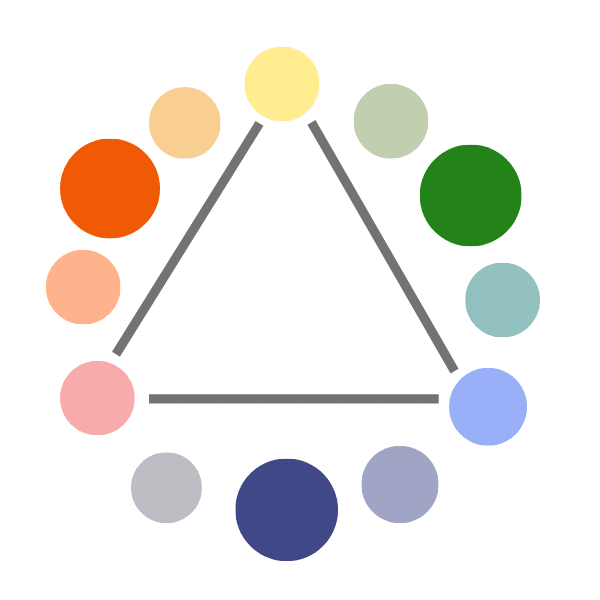
For example, if I mix together the primary colors yellow and red I get orange. And when mixing primary colors blue + yellow I get green. Last but not least, when mixing primary colors blue and red I get purple!
Now, for each of these secondary colors there is a complementary color!
Complementary colors within the color wheel
Each of the secondary colors is a complementary color with a primary color – and the opposite is also true – each of the primary colors is a complementary color with a secondary color.

When looking at the complementary color wheel above you will see that the secondary color purple is the complementary color of yellow, and yellow is the complementary color of purple. Orange is the complementary color of blue and vice versa. And lastly, green is the complementary color of red, and red is the complementary color of green.
You will notice that all complementary colors are opposite each other on the complementary color wheel! So, when looking at a color wheel you can always know that complementary colors are opposite one another.
Complementary colors in action
When you put two complementary colors next to one another it makes them stand out more than they would on their own. For example, look at the image below of the blue square inside the orange square. Both colors stand out much more than they would if they were by themselves.
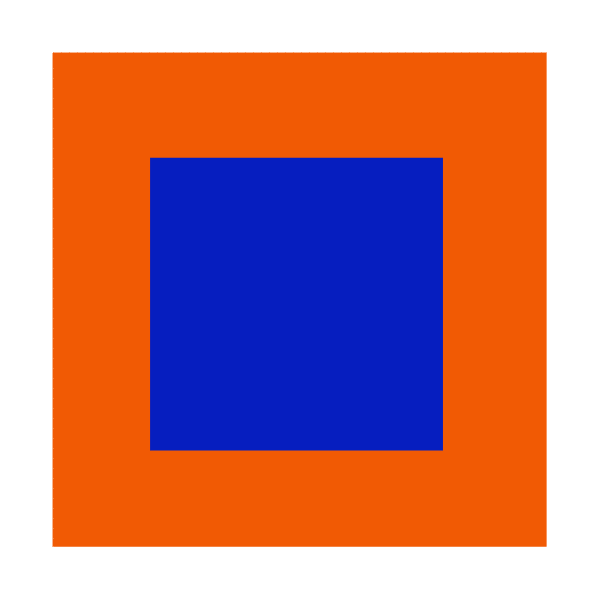
The same holds true for the complementary colors green + red and purple + yellow. Because they are completely opposite, they make each other stand out more.


So, if you ever want to emphasize something in a painting – then use two complementary colors next to one another. I have examples of how this applies to real paintings at the bottom of the article.
Mixing complementary colors
Mixing two complementary colors together will mute your color. So, if you want a muted blue then you would mix some orange to it. The opposite is also true – mix blue into orange to create a muted orange. The same holds true for the other complementary colors.
Muting a color by mixing it with its complementary color creates richer colors. Learn how to put color mixing into practice – I also have this free color mixing guide available to help guide you further. In addition, this article will help you to learn why muted colors are so important to painting.
Tertiary Colors in the color wheel
There are still more colors to talk about with the color wheel! Tertiary colors are also known as intermediate Colors. These colors fill in the gaps between the primary and secondary colors. As you can see in the tertiary color wheel below.

You can get a tertiary color/ intermediate color by mixing one primary color with one secondary color. So, if I mix the primary color yellow with the secondary color green I get the tertiary color yellow-green.
If you are working from life on a painting you will probably not use primary colors or secondary colors in your piece because they are very bright. Rather, it is more likely that you would use some softer colors like tertiary/ intermediate colors. Colors are much more natural when they are mixed.
The rule of complements ALSO applies to tertiary colors. Though the effect tends not to be as dramatic as a primary color mixed with a secondary color.

Notice that the complementary color of each tertiary color is also opposite from it on the color wheel.
What are analogous colors?
Analogous colors definition
Analogous colors are groups of three colors that are next to each other on the color wheel. For example, notice in the color wheel below of how yellow, yellow-green and green are all next to one another. Therefore as a group they are analogous colors.
Analogous Colors examples

Analogous colors are often found in nature and are known to create harmonious designs that are pleasing to the eye. Below is a close up view of the analogous colors highlighted in the color wheel.

Extended analogous colors
There is also such thing as an extended analogous color palette – this would be a group of more than three analogous colors. Think of analogous colors as taking a slice of the color wheel – 3, 4 or at most 5 pieces that are grouped together

Above is an example of a group of five analogous colors taken from the color wheel. You can see that all the colors are related since they are grouped together.
Analogous Colors in Art
Now we can't end the conversation about analogous colors without showing some real life examples from the art world!

This Self Portrait by Vincent Van Gogh is made up of (for the most part) an analogous palette that has a lot of greens and blues – yellow green, green, blue green, blue, and purple blue. You can see the extended analogous palette that Van Gogh used below in his self portrait painting. It is made up of 5 colors and you can see why the colors in the Van Gogh painting are so harmonious.

Complementary colors with an analogous palette
Besides the Van Gogh self portrait having a very analogous palette it also has a splash of complementary colors! Van Gogh's beard and hair is red and orange which are complementary colors for green and blue.
Having complementary color contrast helps to make a painting more dynamic as seen in the Van Gogh painting.
Split complementary colors in the color wheel
A split complementary color scheme is a variation of the complementary color scheme. It uses a color and then the two colors that are adjacent to the complementary colors.
Example of split complementary colors
For example, in the color wheel below you can see that the split complementary colors here are purple, orange-yellow, and yellow green. Orange-yellow and green-yellow are adjacent colors to yellow (the complementary color of purple).
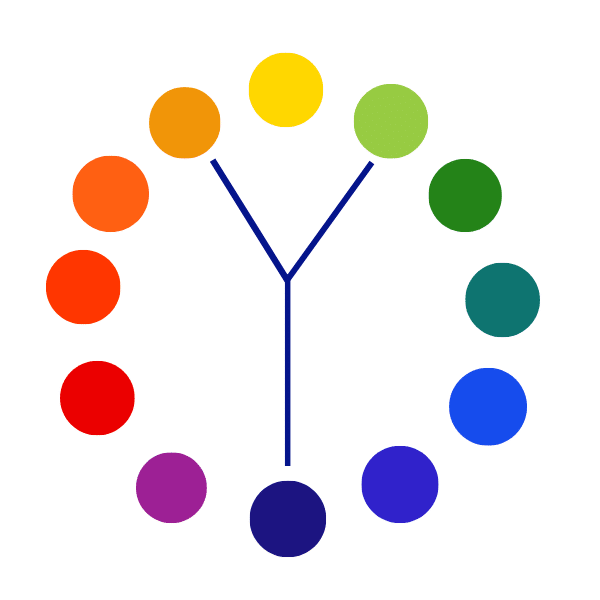

Examples of complementary color schemes in art
Where to find the use of the Color wheel in art
You will commonly find complementary color schemes in art because they work really well for a painting. All of the followings paintings by Vermeer, Degas and Cezanne each use a different complementary color scheme. Keep your eyes peeled next time you head to an art museum – you will be surprised at how many paintings use a complementary color wheel scheme.
Orange – blue complementary color scheme
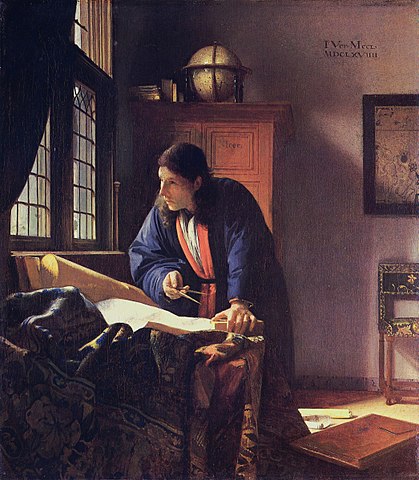
Vermeer's painting 'The Astronomer' is an excellent example of how an orange/blue complementary color scheme can work in a painting. Of course, not ever single area of the painting is either blue or orange. However, the general overall theme for the colors in the painting are blue and orange.
Having a complementary color scheme in a painting works well because the colors (orange and blue in this case) make each other stand out more. This in turn makes the piece stand out to the viewer.
For example, our eyes immediately go to the bright orange trim on the astronomer's robe first because it is set off by being next to its complementary color blue. Vermeer meant for the figure to be the point of focus – which works thanks to the complementary colors.
Yellow – purple complementary scheme

In this Degas painting we see a different kind of complementary color scheme – yellow and purple. The floor is a muted purple color, while the wall is yellow (including a yellow bow on the ballerina).
Having these two complementary colors makes the painting more dynamic by creating an intense color interaction. Our eye first goes to the area where the two complementary colors meet – the dancers. Again, you see here how the artist used complementary colors to guide the eye.
Red – green complementary scheme
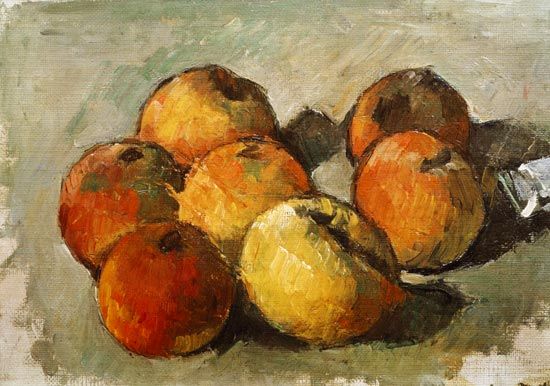
Last but not least we have a still life painting by Cezanne. The complementary color scheme used here is red and green. We have a painting that has a foreground and background that is mainly made up of green or light green. The apples range between deep red and orange.
In a complementary color scheme painting one will never have a piece that is made up of only 2 complementary colors . Rather, there will be a range – and most likely some other colors mixed in as well.
In the Cezanne still life we can see that the red apples really stand out against the green foreground and background! Another example of how complementary colors make certain areas stand out.
Practical application of the color wheel
Having thorough knowledge of color theory and the color wheel is not absolutely necessary to become a great artist. However, knowing the basics of how color works is VERY helpful when it comes to color mixing and making decisions on a color scheme for a painting.
Apply what you learn in this article to your painting. To get more practical application in terms of color mixing of some of the concepts discussed here read the color mixing guide.
All of the concepts in this article are the same whether you work in watercolor, acrylic, oil paints, gouache or any other medium! The rules of color mixing are universal so you can apply it to anything you do. So, go and explore the world of color and have fun color mixing. 🙂
Source: https://artstudiolife.com/color-wheel-for-artists/
Post a Comment for "Where Is an Analogous Color for Blue on the Color Wheel"